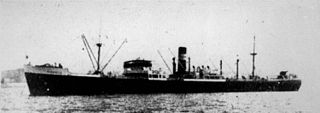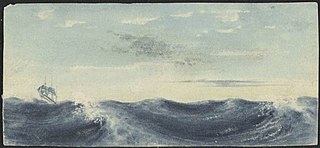Citations
- ↑ "Arrival of the West India Mails". The Morning Post. No. 22570. London. 20 May 1843.
Several vessels have been named Abeona for one of the Roman birth and childhood deities.

East Indiaman was a general name for any sailing ship operating under charter or licence to any of the East India trading companies of the major European trading powers of the 17th through the 19th centuries. The term is used to refer to vessels belonging to the Austrian, Danish, Dutch, English, French, Portuguese, or Swedish companies.

Marlborough was an iron-built two-decked merchant sailing ship which disappeared in 1890. She was built by the firm of Robert Duncan and Co., Port Glasgow and launched in 1876 for her owner John Leslie, who later sold her to the Albion Line. Marlborough disappeared during a voyage in January 1890, and has not been seen or heard from in over a century. Searches and investigations have yielded nothing conclusive, and the ship's ultimate fate, and that of her crew, remains unknown.

Red Jacket was a clipper ship, one of the largest and fastest ever built. She was also the first ship of the White Star Line company. She was named after Sagoyewatha, a famous Seneca Indian chief, called "Red Jacket" by settlers. She was designed by Samuel Hartt Pook, built by George Thomas in Rockland, Maine, and launched in 1853, the last ship to be launched from this yard.

SS Hopestar was a 5,267 GRT cargo ship that was built in 1936 by Swan, Hunter and Wigham Richardson Ltd, Newcastle upon Tyne, Northumberland for the Wallsend Shipping Co Ltd. She sank off the coast of Newfoundland in 1948 with the loss of all 40 crew.
A number of vessel were named Caroline:
Abeona was launched at Newcastle-upon-Tyne in 1811. A fire at sea destroyed her in November 1820, killing many passengers and crew.
Alacrity was launched at Newcastle-on-Tyne in 1814. New owners transferred her registry to London and she then spent much of her career sailing between Britain and the Cape of Good Hope, sometimes going on to India. She made at least one voyage to New South Wales. New owners in 1829 returned her registry to Newcastle. She was wrecked in 1830.
Several ships have been named Alacrity:
Several ships have been named Woodlark after the woodlark:
Several vessels have been named Brilliant:
Several vessels have been named Prince George:
Several vessels have been named Duchess of Buccleugh or Duchess of Buccleuch for one or another Duchess of Buccleuch:
Several ships have been named Trent:

Africaine, was a barque launched in 1831 at Jarrow on the River Tyne in England. In 1836 she carried immigrants as part of the First Fleet of South Australia. She was wrecked on 23 September 1843.
Some 20 vessels have been built on the River Tyne and have been named Tyne for it. In addition, some vessels built elsewhere have also been named Tyne.
Several vessels have been named Intrepid:
Several vessels have been named Atalanta after the athlete Atalanta in ancient Greek mythology.
Several sailing vessels have been named Indus, after the Indus River, or the constellation Indus: